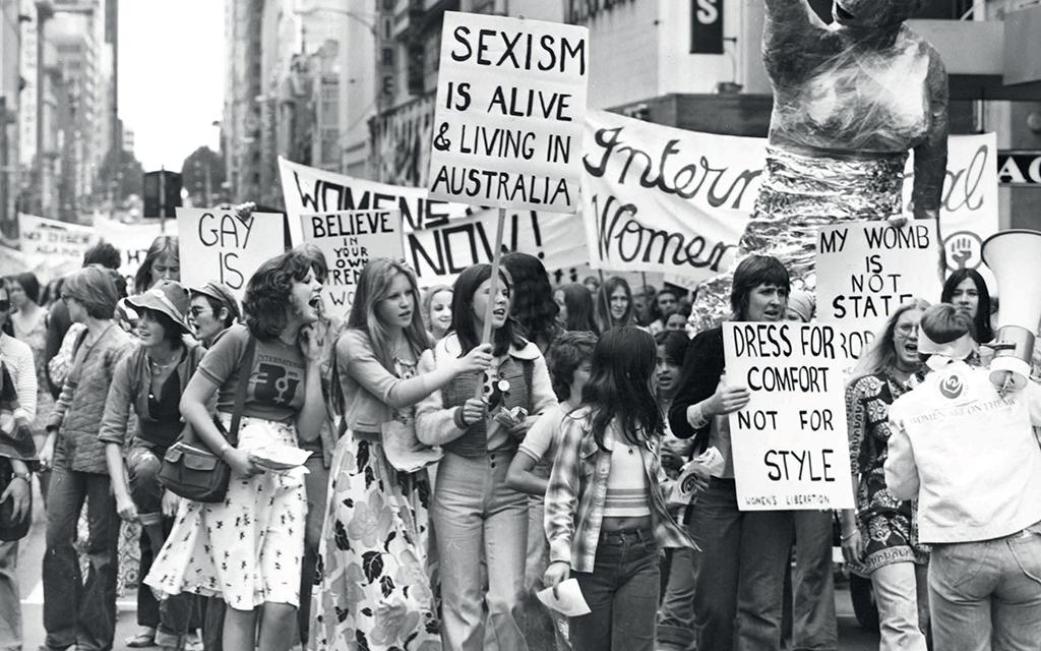What Do We Want?
The Story Of Protest In Australia
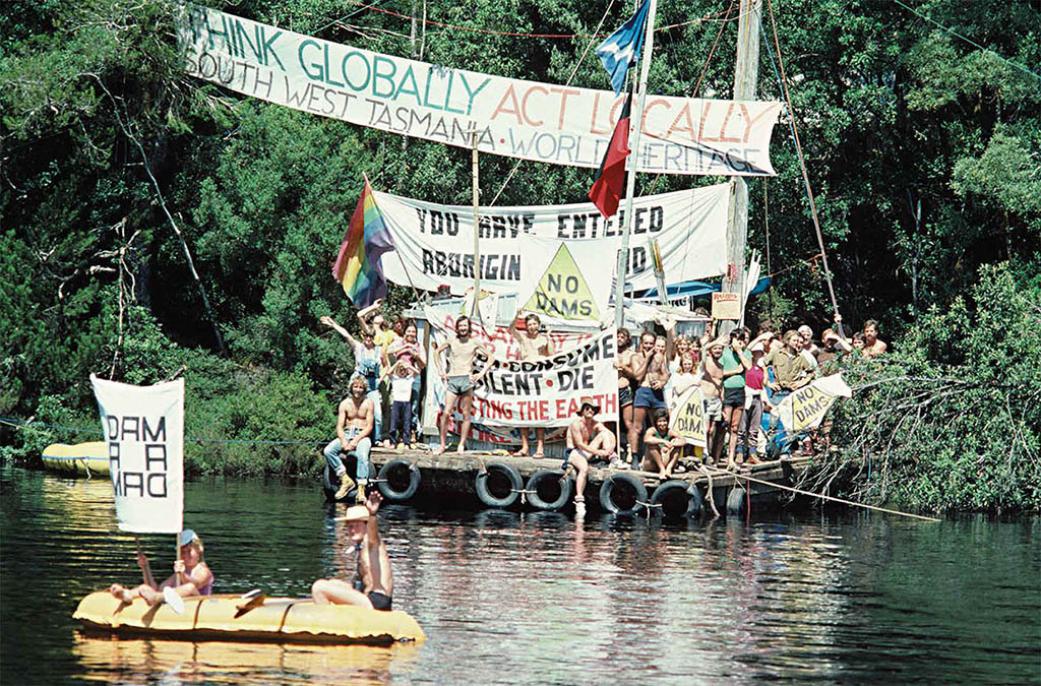
What Do We Want?
The story of protest in Australia
The first big protest I ever attended was the 1985 Palm Sunday anti-nuclear rally in Sydney, in town. When you find it difficult to stray beyond the Narrabeen bridge, town is a long way away and you only go there for a very good reason. I was part of a crowd of 170,000 people who brought the city to a standstill that day though, and, is the case in these things, looked across the crowd and could spot one after another of my fellow Whaley and Palm Beach residents among all those faces.
It was a peaceful march and we knew we were doing the right thing in an era of end of cold war histrionics and the falling the Berlin Wall – wanting to not blow each other up, wanting people to be able to live freely and not under oppressive murderous regimes seemed then, and remains, perfectly reasonable.
As a teenager, prior to being old enough to be able to vote, I’d write letters to Canberra, signing them ‘A. Guesdon', as that’s my name, and receive answers addressed to ‘Mr. A Guesdon’, such was the mindset down south. That settled it immediately of course; I’ve been ‘A. J. Guesdon’ ever since. Dad wasn’t impressed, on opening these replies addressed to him, but he got it then and he gets it now.
In 2016 we have seen protests by the score, despite a new NSW State Government law which decrees protests that get in the way of installing permanent big black holes in the ground or poisoning the Artesian Basin's flows are now outlawed….although no one has been gaoled yet for wearing bicycle chains as bracelets!
Many have certainly been pushed around though – those trying to save the ANZAC figs found the ground shifting beneath their feet from being public footpath to ‘inclosed’ lands making them subject to arrest and multi-thousand dollar fines. Those trying to save precious land from the pillagers in the name of coal, in a land that has more sunshine, and thus solar, than anywhere, found themselves subject to bullying and some rather grubby arrest experiences. Those who wanted to retain their local government in the form of an elected council, despite gathering in Martin Place, outside LGNSW conferences or letting everyone know 89% prefer to not be amalgamated, found themselves and their choice irrelevant unless they were lucky enough to be represented by councillors and mayors who actually took what the people wanted them to do as what they were meant to do and went to court to retain their rights.
Some councils still stand thereby… those that did not have fallen.
Then, and now, many of us are anxious to save the trees, save the rivers and all their streams, and thereby, the future air our children and grandchildren breathe.
I remember arguing with one uncle who scoffed at such notions decades ago during my letter-writing phase; he was convinced the trees were endless, that they didn’t matter but economic development did, that I was a fool. What stopped him, or 'stumped' him, was asking did he think his grandchildren deserved to be able to walk through a pristine forest and gaze up at trees as tall as those that had crowned his childhood – he fell silent – then; yes he did think they deserved to have such treasures too.
Of course you get labelled then, it’s called ‘politics’ and you’re a disgrace due to not following the family’s, for generations, creed – when really what it definitely is is being a human being who will stand up and say, ‘I object!’.
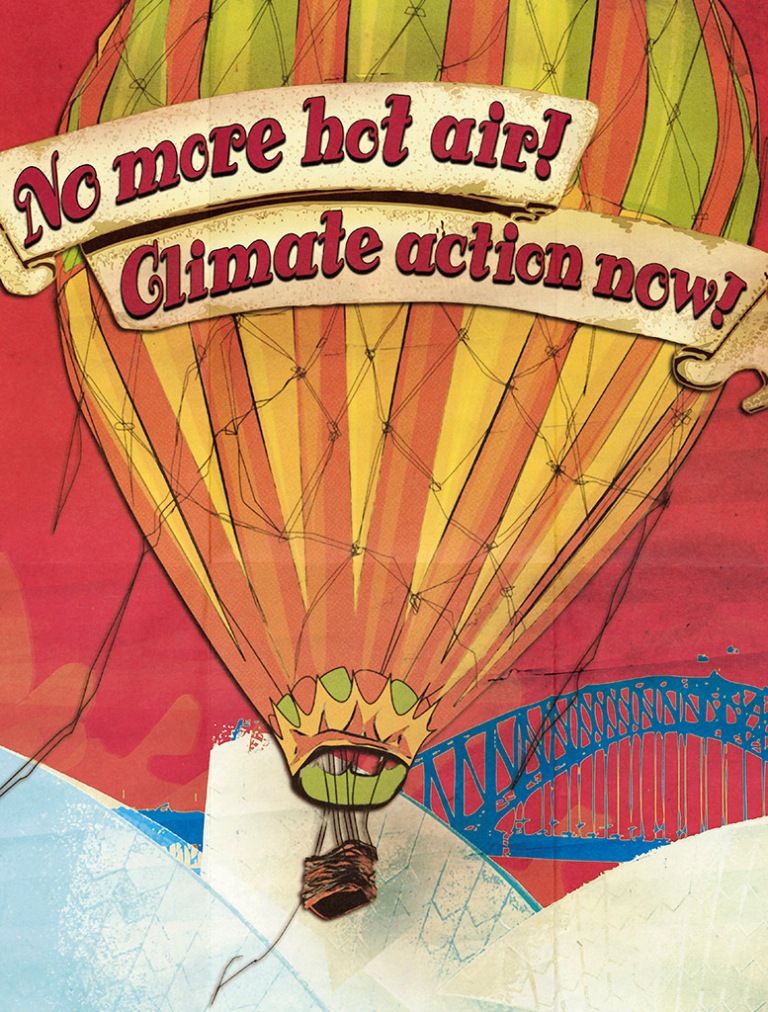
From page 156 - No More Hot Air! Climate Action Now! (Australian Conservation Foundation, 2009). nla.gov.au/nla.cat-vn6890040
Over the decades protestors have been instrumental in driving important social movements that define life in modern Australia, yet our colourful history of protest has never been told.
In the recently released book, What Do We Want?, Professor of Public Ethics, Centre For Applied Philosophy & Public Ethics (CAPPE), Charles Sturt University Clive Hamilton shares the stories behind the greatest social movements in Australia: the brave leaders, protest casualties and the vicious retaliation. He examines how movements for equality, peace and environmental action have confronted the ugliness in Australian society and caused revolutionary shifts in social attitudes.
Mr. Hamilton also looks at the creativity of our protestors: marching or sitting down in the streets of capital cities; singing at bulldozers in Australia's forests; chaining bodies to buildings; using technology to disrupt stock markets; coming out on television; taking part in vigils, leafleting, street theatre, and many other powerful and disruptive forms of protest.
Last week Prof. Hamilton published something about this new National Library of Australia book in The Conversation:
What do we want? Charting the rise and fall of protest in Australia
In 1965, when a few hundred anti-Vietnam War protesters in Sydney, Melbourne and Canberra staged Australia’s first ever sit-down demonstrations, the authorities were apoplectic. How dare these agitators block the traffic and defy authority?
At the 1970 Vietnam Moratorium rallies around Australia, 200,000 marched against the war. Even the police were afraid. It was seen as a turning point in our history. The game was up. Our troops would have to be withdrawn from Vietnam, and across the nation people came to believe that taking to the streets could change the world.
In 2003, when the government under John Howard deployed troops to fight in Iraq, 600,000 Australians marched in protest. It was a number never approached before and in all likelihood will never be exceeded. But despite their massive size, the protests were simply ignored.
Many of those who had joined the rallies became disillusioned. In Australia and other places where similar protests proved futile, demonstrators could no longer believe that marching in the streets could make a difference.
Today protests have become a commonplace, even banal, part of political life. Back then the tabloids screamed “Mob rule!” and so did the politicians. So debased has the act of protest become that in response to the mining tax in 2010 Australia’s then second-richest person, Gina Rinehart, could mount a flatbed truck and bellow “axe the tax” to an assembly of well-dressed company employees sent along for the cameras.
For those whose understanding of the act of protest was formed in the decades when every demonstration was greeted by the authorities as a threat to the stability of the social order, the protests of some of Australia’s richest left a sick feeling. What had happened since the glory days of protest in the 1960s and 1970s?
Old left, new left
This is just one of the conundrums I came up against while writing my new book, What Do We Want? The story of protest in Australia, commissioned and published by the National Library of Australia as part of its program of making better use of its rich archives of photos and images.
When we think about the story of protest in Australia we are naturally drawn to the upheavals of the late 1960s and 1970s because it was then that powerful waves of dissent broke over Australia. Australians who entered the 1960s feeling comfortable and relaxed soon discovered they were sitting on a volcano.
Compared to the worldview of the Old Left, the new social movements – for peace, women’s liberation, gay rights and Aboriginal justice – understood power and oppression in new and more complex ways. The New Left that grew out of these protest movements focused less on economic inequality and exploitation, and more on forms of oppression embedded in social structures and the broader culture. The target was conservatism rather than capitalism.
Still, the Old Left, tied to the trade union movement, played a vital mobilising role in the rise of the new social movements. The Communist Party of Australia (CPA) had long been active in the peace movement and it was natural for it to oppose American and Australian military intervention in Vietnam. Members of its youth wing, the Eureka Youth League, staged perhaps the first demonstration against the Vietnam War as early as 1963.
Women members of the Party were also prominent as the second-wave of feminism took shape. Arguably, the first tremor of the new phase of the women’s movement was felt in 1967 when Zelda D’Aprano – a party member and clerk at the Meatworkers Union – chained herself to the Commonwealth Building in Melbourne in support of equal pay. Three years later she and a friend famously boarded a tram and insisted on paying only 75% of the fare because they were paid only 75% of men’s wages.
Red to green?
Even in the early years of gay liberation, activists who were also members of the CPA had a prominent role, working to radicalise the emerging movement. They argued (wrongly as it turned out) that discrimination against homosexuals was part of the broader pattern of capitalist oppression.
It was this implied solidarity that in 1974 saw the communist-led Builders Labourers Federation place a black ban on work at Macquarie University after the University excluded trainee teacher Penny Short because she had come out as a lesbian.
But ironically, given the hysterical claims of today’s conservatives that environmentalism is little more than socialism dressed in a green disguise, the Old Left played no role in the formation of the modern environment movement. In fact, it was often hostile to what appeared to be a middle-class indulgence.
There were exceptions – notably the “green bans” of the early 1970s staged by the Builders Labourers Federation – but, as any climate activist will attest, the battle for a safe climate has until recently been as much with unions as with the “greenhouse mafia” - the group of industry lobbyists who played a key role in climate policy under John Howard.
So the activism of the new social movements of the 1960s challenged the traditional left as well as conservatives. The New Left’s emerging agenda of social change began to eclipse the Old Left, locked as it was into the belief that only organised labour could create a new social order.
When economic change and the rise of the New Right in the 1980s saw the collapse of union power, the Old Left was history.
by Clive Hamilton
________________________
What Do We Want? honours the passion, courage and commitment of the activists who have sought to make Australia a better place, those who stood up—or sat down—in the face of prejudice or intolerance, and who continue to do so today.
Examining ourselves, honestly, keeping our eyes on how we would rather be by continually redefining that and protesting when those aspiration fail to be met, has helped us become and move closer towards being a healthier society.
As long as we make the effort to attend the rallies, to write the letters, to put forth our input, to stand up and speak out, we as a species may overcome what seems close to overwhelming us environmentally, socially, and economically if the measly dollar rules the day. 'Worth' has an older definition than that applied to it currently, that of "excellence of character or quality as commanding esteem" - which is what is at the heart of all genuine, and getting us closer to true, protest - without it America would not have had a civil war against slavery and then a civil rights movement, while here, we women would still be in the kitchen dressed in posies and apron, and on the land, the land and river would be gone, and in our hearts, we would not be able to hear the songlines of this place's original custodians.
The conversations must not cease - nor should the protest songs.
Clive Hamilton will be discussing his new book with David McKnight at Gleebooks in Sydney at 6 pm on Thursday November 24.
Details on how to get this excellent new book from the NLA run below.
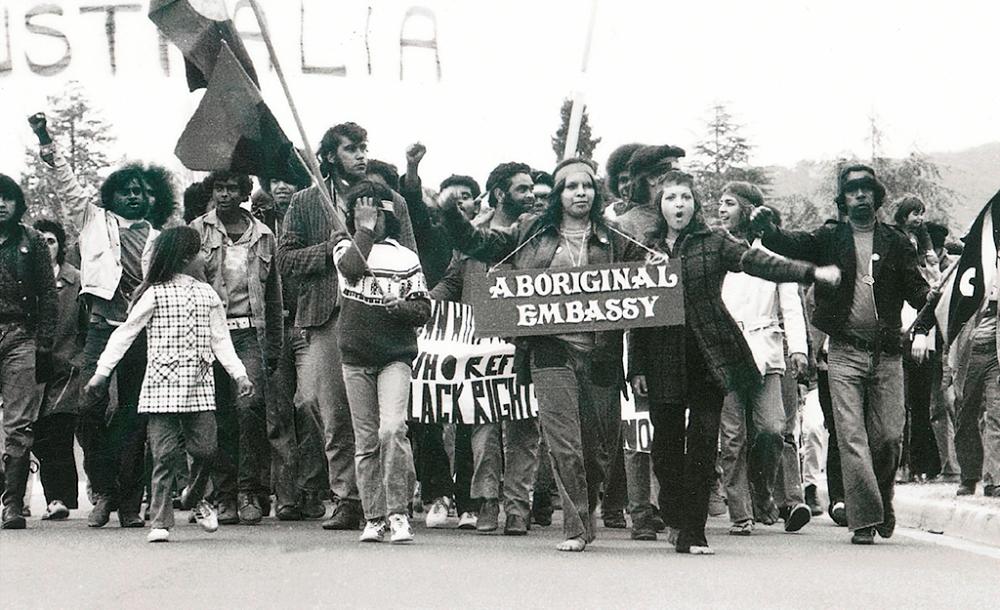
From page 117 - Demonstration with aboriginal Embassy - Placard at Land Rights demonstration, Parliament House, Canberra 1972 - photo by Ken Middleton - nla.ov.au/nla.cat - vn3256023
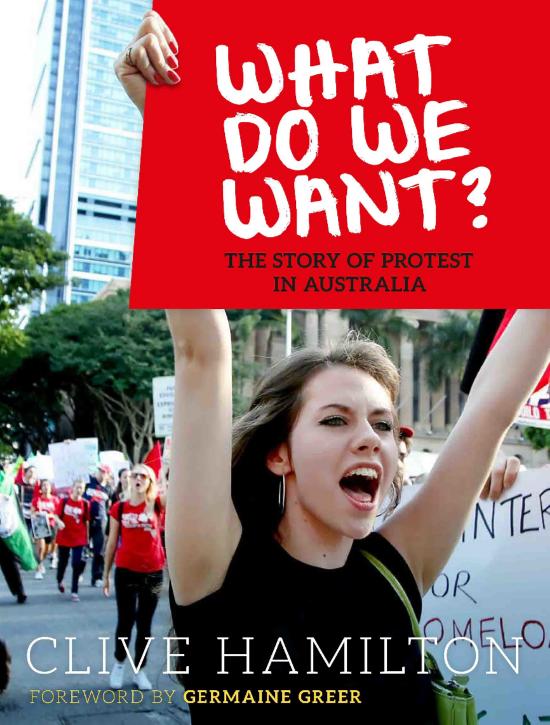 What Do We Want?
What Do We Want?
The Story of Protest in Australia
By: Clive Hamilton, Foreword by Germaine Greer
In What Do We Want! Clive Hamilton explores the colourful, enthralling and stirring forms of protest used in the big social movements that define modern Australia. He includes dedicated chapters on the peace movement, women's liberation, Indigenous rights, gay rights and the environmental movement, and examines how these movements have confronted the ugliness in Australian society and caused epoch defining shifts in social attitudes.
He describes protests with scores of thousands marching or sitting down in the streets of capital cities; colourful camps of a handful of protestors in Australia's forests, singing at bulldozers and blocking paths; acts of bravery by individuals using technology to disrupt stock markets or coming out on television; as well as vigils, leafleting, street theatre, occupations and myriad other creative forms of protest. Hamilton shows that progress occurs because a few individuals begin to demand it.
About the Author
Clive Hamilton is Professor of Public Ethics at Charles Sturt University in Canberra. Previously he was the Executive Director of the Australia Institute, a progressive think tank he founded. He is the author of a number of influential books, including Growth Fetish, Requiem for a Species: Why We Resist the Truth about Climate Change and Earthmasters: Playing God with the Climate.
